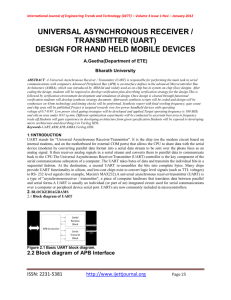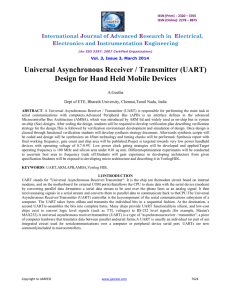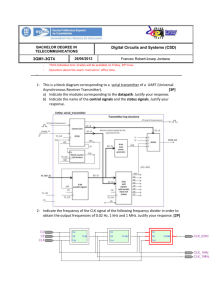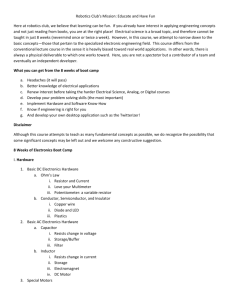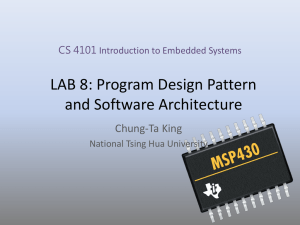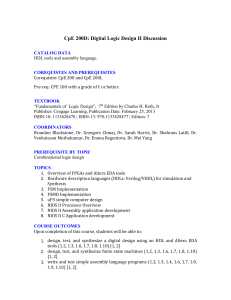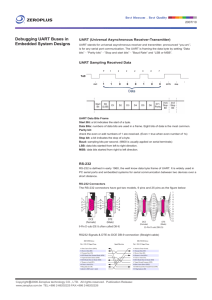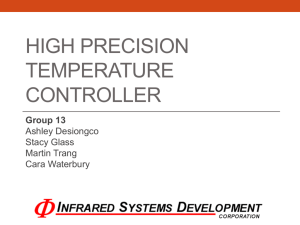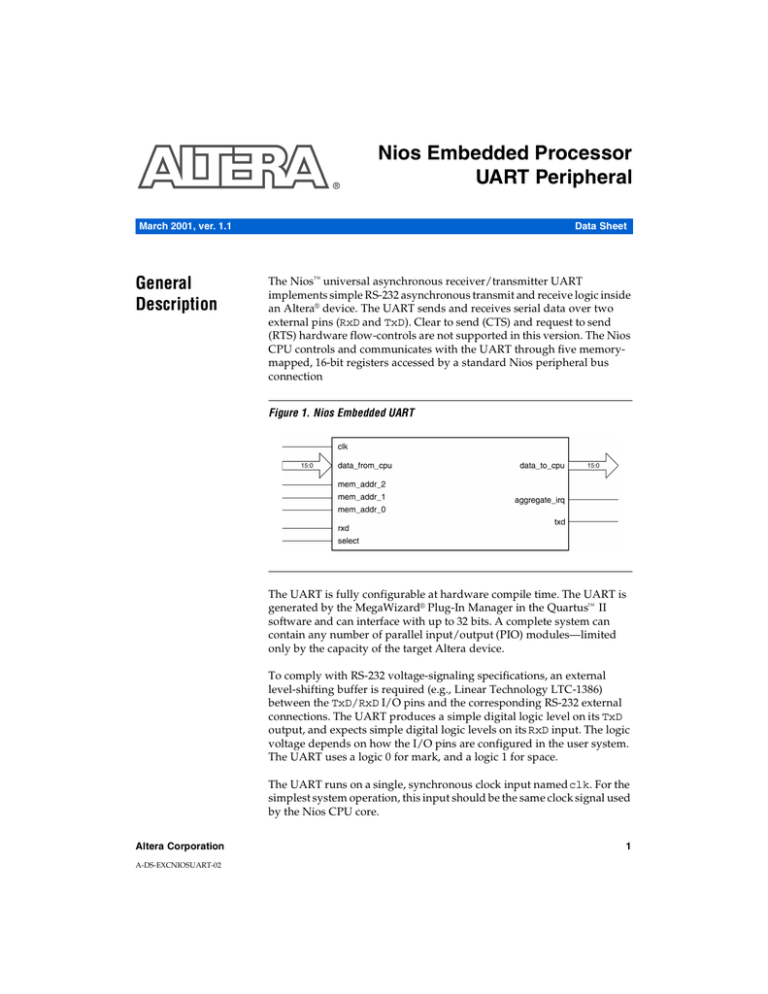
Nios Embedded Processor
UART Peripheral
March 2001, ver. 1.1
General
Description
Data Sheet
The Nios™ universal asynchronous receiver/transmitter UART
implements simple RS-232 asynchronous transmit and receive logic inside
an Altera® device. The UART sends and receives serial data over two
external pins (RxD and TxD). Clear to send (CTS) and request to send
(RTS) hardware flow-controls are not supported in this version. The Nios
CPU controls and communicates with the UART through five memorymapped, 16-bit registers accessed by a standard Nios peripheral bus
connection
Figure 1. Nios Embedded UART
The UART is fully configurable at hardware compile time. The UART is
generated by the MegaWizard® Plug-In Manager in the Quartus™ II
software and can interface with up to 32 bits. A complete system can
contain any number of parallel input/output (PIO) modules—limited
only by the capacity of the target Altera device.
To comply with RS-232 voltage-signaling specifications, an external
level-shifting buffer is required (e.g., Linear Technology LTC-1386)
between the TxD/RxD I/O pins and the corresponding RS-232 external
connections. The UART produces a simple digital logic level on its TxD
output, and expects simple digital logic levels on its RxD input. The logic
voltage depends on how the I/O pins are configured in the user system.
The UART uses a logic 0 for mark, and a logic 1 for space.
The UART runs on a single, synchronous clock input named clk. For the
simplest system operation, this input should be the same clock signal used
by the Nios CPU core.
Altera Corporation
A-DS-EXCNIOSUART-02
1
Nios Embedded Processor UART Peripheral
Transmitter
Logic
The UART transmitter consists of a 7- or 8-bit TxData holding register and
a 7- or 8-bit transmit shift register (the number of data bits is configured at
hardware compile time). The TxData holding register is directly written
by the host. The transmit shift register directly feeds the TxD data pin.
Data is shifted out to TxD least significant bit (LSB) first. The transmit shift
register is automatically loaded from the TxData register whenever a
serial transmit shift operation is not currently in process.
These two registers provide double buffering; the host can write a new
value into the TxData register while the previously written character is
being shifted out. The Nios CPU can monitor the status of the transmitter
by reading the transmitter ready (TRDY), transmitter shift register empty
(TMT), and transmitter override error (TOE) bits in the Status register.
The transmitter logic automatically inserts the correct number of start,
stop, and parity bits in the serial TxD data stream as required by the
RS-232 specification and determined by the compile-time UART
configuration.
Receiver Logic
The UART receiver consists of a 7- or 8-bit receiver-shift register and a
7- or 8-bit RxData holding register (the number of data bits is configured
at compile time). The RxData holding register can be read directly by the
host. The RxData holding register is loaded from the receiver shift register
automatically every time a new character is fully received.
These two registers provide double buffering. The RxData register can
hold a previously received character, while the subsequent character is
being shifted into the receiver shift register.
The host can monitor the status of the receiver by reading the read-ready
(RRDY), receiver-overrun error (ROE), break detect (BRK), parity error
(PE), and framing error (FE), bits in the Status register. The receiver logic
automatically detects the correct number of start, stop, and parity bits in
the serial RxD stream as required by the RS-232 specification, and as
determined by the hardware compile time UART configuration. The
receiver logic checks for four exceptional conditions in the received data,
and sets corresponding bits in the Status register:
■
■
■
2
FE bit—A framing error occurs whenever the receiver fails to detect a
correct stop bit.
PE bit—A parity error occurs if the received parity bit has an
unexpected (incorrect) logic level. If the UART is configured with the
hardware compile time option UART_PARITY = N, no paritychecking is performed and the PE bit will always be 0.
ROE bit—A receiver-overrun error occurs whenever a newlyreceived character is transferred into the RxData holding register
before the previous character is read by the host. In this case, the ROE
Altera Corporation
Nios Embedded Processor UART Peripheral
■
Baud Rate
Generation
error-bit is set to 1, and the previous contents of the RxData register
is overwritten with the newly-received character.
BRK bit—The receiver logic detects a break whenever the RxD pin is
held low (logic 0) continuously for longer than a full-character time
(7 or 8 bit-times, plus start, stop, and parity bits). When a break is
detected, the BRK bit in the Status register is set to 1.
The UART's internal baud clock is derived from the UART's master clock
input (which should be the same as the Nios system clock). The internal
baud clock is generated by a clock divider. The divisor value can come
from one of two sources:
1.
A constant value set by the UART_BAUD_RATE and
UART_INPUT_CLOCK_FREQ hardware-compile-time parameters.
2.
The host-settable 16-bit value in the Divisor control register.
The UART uses a host-settable baud-rate-divisor register—if the
hardware-compile-time option UART_FIXED_BAUD_RATE is set to NO.
The UART uses a fixed baud rate if the UART_FIXED_BAUD_RATE option
is set to YES.
Register
Descriptions
A description of the bits and internal addresses of the Status register
follows. Table 1 describes the Nios UART register map.
Table 1. Nios UART Register Map
A2..A0
Register
Name
0
Rx Data1
2
1
Tx Data
2
Status3
3
Control4
4
Divisor
15
……
9
8
7
6
5
4
3
2
1
0
Rx Data
Tx Data
TBRK
E5
RRDY TRDY TMT
TOE
BRK
FE
PE
iE
iRRDY iTRDY iTMT
iTOE iROE iBRK
iFE
iPE
ROE
Baud Rate Divisor (optional)
Notes
(1)
(2)
(3)
(4)
(5)
Read— only value.
Write— event register. A write–operation to this address causes an event in the device.
A write–operation to the Status register clears these bits: E, TOE, ROE, BRK, FE, PE.
Host–written control value. Can be read–back at any time.
Status bit 8 (E) is the logical OR of the TOE, ROE, BRK, FE and PE bits.
Altera Corporation
3
Nios Embedded Processor UART Peripheral
RxData—Internal Address 0
The host reads received characters from the RxData register. Whenever a
new character is fully received via the RxD input, it is transferred into the
RxData register, and the RRDY bit in the Status register is set to a 1.
Whenever the host reads a value from the RxData register, the RRDY bit
in the Status register is cleared (set to 0). If a character is transferred into
the RxData register when the RRDY bit is set (i.e., if the host has not
retrieved the previous character), a receiver-overrun error occurs, and the
ROE bit in the Status register is set to a 1. New characters are always
transferred into the RxData register, whether or not the host retrieved the
previous character. Writing data to the RxData register has no effect.
TxData—Internal Address 1
The host writes characters to be transmitted directly into the TxData
register. The host should not write any characters to the TxData register
until the transmitter is ready for a new character (as indicated by the
TRDY bit in the Status register). If the host writes a character to the TxData
register when TRDY is a 0, the results are undefined. The TRDY bit is set
to a 0 whenever the host writes a character into the TxData register. The
TRDY bit is set to a 1 whenever a character is transferred from the TxData
register into the transmitter shift register.
For example, assume the UART is idle and the host writes a first character
into the TxData register. The TRDY bit is set to a 0, and then immediately
set to a 1 again when the character is transferred into the transmitter shift
register. The host can then write a second character into the TxData
register, at which point TRDY is set to a 0 again. However this time, the
first character still occupies the transmitter-shift register, and is still in the
comparatively slow process of being transmitted over the TxD output pin.
The TRDY bit is not set to 1 until the first character has been fully shifted
out, and the second character is automatically transferred into the
transmitter shift register. Reading data from the TxData register produces
an undefined result.
Status—Internal Address 2
The Status register consists of individual bits, each of which indicates a
particular condition inside the UART. The Status register can be read at
any time by the host. Reading the Status register does not change the value
of any of the bits. Each of the status bits is associated with a corresponding
interrupt-enable bit in the Control register. If a status bit's corresponding
interrupt-enable is true (1), a true (1) condition on that status bit will cause
an interrupt-request to be sent to the host.
4
Altera Corporation
Nios Embedded Processor UART Peripheral
The bits in the Status register are as follows:
■
PE (bit 0)—The PE bit is set true (1) if the UART receives a character
with an incorrect parity bit. This bit is always false (0) if the hardware
compile time option UART_PARITY is set to N (None).
The PE bit is cleared (set to 0) whenever the host performs a writeoperation to the Status register.
■
FE (bit 1)—The FE bit is set true (1) if the UART receives a character
with an incorrect stop bit.
The FE bit is cleared (set to 0) whenever the host performs a write
operation to the Status register.
■
BRK (bit 2)—The BRK bit is set true (1) if the UART receives a break
character. A break character is defined as a contiguous string of mark
bits (logic 0) presented on the RxD pin that lasts longer than a full
character time.
The BRK bit is cleared (set to 0) whenever the host performs a write
operation to the Status register.
■
ROE (bit 3)—The ROE bit is set true (1) if the UART transfers a new
character into the RxData holding register while the RRDY bit is 1
(i.e., before the host has retrieved the previous character).
The ROE bit is cleared (set to 0) whenever the host performs a write
operation to the Status register.
■
TOE (bit 4)—The TOE bit is set true (1) if the processor writes a new
character into the TxData holding register while the TRDY bit is 0
(i.e., before the previous character has been transferred into the
transmitter shift register).
The TOE bit is cleared (set to 0) whenever the host performs a write
operation to the Status register.
■
TMT (bit 5)—The TMT bit indicates the current state of the
transmitter shift register. If the transmitter shift register is in the
process of shifting a character out the TxD pin, TMT is set to a 0. If the
transmitter shift register is idle (i.e., a character is not being
transmitted) the TMT bit is 1. The host can determine if a
transmission has been completed (and should have been received at
the other end of a serial link) by checking the TMT bit.
The TMT bit is not changed by a write operation to the Status register.
■
Altera Corporation
TRDY (bit 6)—The TRDY bit indicates the current state of the TxData
holding register. If the TxData holding register is empty (i.e., if its
contents have been transferred to the transmitter shift register), it is
ready for a new character and TRDY is a 1. If the value in the TxData
register has not been transferred into the transmitter shift register
(because the transmitter shift register is busy shifting out the
5
Nios Embedded Processor UART Peripheral
previous character), TRDY is a 0. The host should always wait for
TRDY to be true (1) before writing a new character into the TxData
register.
The TRDY bit is not changed by a write operation to the Status
register.
■
RRDY (bit 7)—The RRDY bit indicates the current state of the RxData
holding register. If the RxData holding register is empty (i.e., if the
UART has not received any new characters), it is not ready to be read
and RRDY is a 0. When a newly received value is transferred into the
RxData register, RRDY is set to a 1. RRDY is cleared (set to 0) when
the host performs a read-operation on the RxData register. The host
should always wait for RRDY to be true (1) before reading a character
from the RxData register.
The RRDY bit is not changed by a write-operation to the status
register.
■
E (bit 8)—The exception condition (E) bit is a simple logical-OR of the
TOE, ROE, BRK, FE, and PE status bits. Strictly speaking, the E bit is
redundant since the same information can be derived from reading
the aforementioned bits individually. It does, however, provide a
convenient method for the processor to determine that something
exceptional is occurring with the UART other than the normal
character transactions. The E bit and corresponding interrupt-enable
exception condition (iE) bit also provide a convenient method for
enabling/disabling interrupts for all error conditions.
The E bit is cleared by a write operation to the Status register because
all of its constituent bits are cleared by this action.
Control—Internal Address 3
The Control register is composed of individual bits, each of which controls
the internal operation of the UART. The value in the Control register can
be read at any time by the host. The bits in the Control register are:
(iE–bit 8), interrupt-enable read ready (iRRDY–bit 7), interrupt-enable
transmission ready (iTRDY –bit 6), interrupt-enable transmitter shift
register empty (iTMT–bit 5), interrupt-enable transmitter override error
(iTOE–bit 4), interrupt-enable receiver overrun error (iROE–bit 3),
interrupt-enable break detect (iBRK–bit 2), interrupt-enable framing error
(iFE– bit 1), and interrupt-enable parity error (iPE–bit 0). These register
bits give the host complete flexibility to determine which, if any, internal
conditions of the UART will result in an interrupt request to the host.
6
Altera Corporation
Nios Embedded Processor UART Peripheral
Each bit in the Status register has a corresponding interrupt enable bit in
the Control register at the same bit position. For example, the PE bit is bit
0 of the Status register, and the corresponding iPE bit is bit-0 of the Control
register. For each bit of the Status register, an interrupt request to the host
is generated if both the status-bit and its corresponding interrupt enable
bit are both true (1).
■
TBRK (bit 9)—The transmit break (TBRK) bit allows the host to
transmit a break-character over the UART's TxD pin under software
control. The TxD pin is driven low (0) whenever the TBRK bit is true
(1). The TBRK pin overrides any normal logic level that the
transmitter logic may have otherwise been driving on the TxD pin.
The TBRK bit interferes with any transmission in process, and it is the
host's responsibility to release the TBRK bit (set it back to 0) after an
appropriate break period has elapsed. The host software determines
an appropriate break period.
Divisor—Internal Address 4
The Divisor register is only implemented if the hardware compile time
option UART_FIXED_BAUD_RATE is set to No. If this option is set to YES
the Divisor register does not exist. The write operations to the Divisor
register will have no effect, and the result of a read operation from the
Divisor register is undefined.
If UART_FIXED_BAUD_RATE is set to No, the contents of the Divisor
register are used to generate the UART's baud-rate clock. The final baud
rate of the UART can be computed by this formula:
Baud Rate = (clock-frequency) / (Divisor + 1).
The host can read-back the value in the Divisor register at any time.
Interrupt
Outputs
The UART produces three separate interrupt request signals:
■
■
■
AGGREGATE_IRQ
RRDY_IRQ
TRDY_IRQ
The UART sets the AGGREGATE_IRQ signal true (1) if any bit in the Status
register and its corresponding interrupt enable bit in the Control register
are both true (1). The host can disable interrupts by writing a zero
(0×0000) to the Control register, thereby setting all the interrupt enable
bits false. The RRDY and TRDY interrupt signals can be separated out
from the AGGREGATE_IRQ signal using compile-time options described
below.
Altera Corporation
7
Nios Embedded Processor UART Peripheral
If the hardware compile time option UART_SEPARATE_RRDY_IRQ is set
to YES, the rrdy_irq signal is driven true (1) if both the RRDY bit in the
Status register is true and the iRRDY interrupt enable bit in the Control
register is true. Further, if UART_SEPARATE_RRDY_IRQ is set to YES the
RRDY bit does not cause the AGGREGATE_IRQ output to go true. A
separate interrupt signal for RRDY allows the host software to use
different interrupt service routines to handle routine arrival of characters
as opposed to exceptional or erroneous events.
If the hardware compile time option UART_SEPARATE_TRDY_IRQ is set
to YES, the TRDY_IRQ signal is driven true (1) if both the TRDY bit in the
Status register and the iTRDY interrupt enable bit in the Control register
are true. Further, if UART_SEPARATE_TRDY_IRQ is YES, the TRDY bit
does not cause the AGGREGATE_IRQ output to go true. A separate
interrupt signal for TRDY allows the host software to use different
interrupt service routines to handle routine arrival of characters, as
opposed to exceptional or erroneous events.
UART Software
Routines
f
101 Innovation Drive
San Jose, CA 95134
(408) 544-7000
http://www.altera.com
Applications Hotline:
(800) 800-EPLD
Customer Marketing:
(408) 544-7104
Literature Services:
lit_req@altera.com
If there is one or more UART peripheral present in the Nios system, the
UART peripheral software routines are available in the Nios library
(.lib folder in the custom software development kit).
For more information regarding software routine calls and custom
software development kits, please refer to the Nios Software Development
Reference Manual.
Altera, APEX, ACEX, FLEX, MegaWizard, and Nios are trademarks and/or service marks of Altera
Corporation in the United States and other countries. Altera acknowledges the trademarks of other
organizations for their respective products or services mentioned in this document. Altera products are
protected under numerous U.S. and foreign patents and pending applications, maskwork rights, and
copyrights. Altera warrants performance of its semiconductor products to current specifications in accordance
with Altera’s standard warranty, but reserves the right to make changes to any products and services at any
time without notice. Altera assumes no responsibility or liability arising out of the application
or use of any information, product, or service described herein except as expressly agreed to
in writing by Altera Corporation. Altera customers are advised to obtain the latest version of
device specifications before relying on any published information and before placing orders
for products or services.
Copyright 2001 Altera Corporation. All rights reserved.
8
Altera Corporation
Printed on Recycled Paper.

